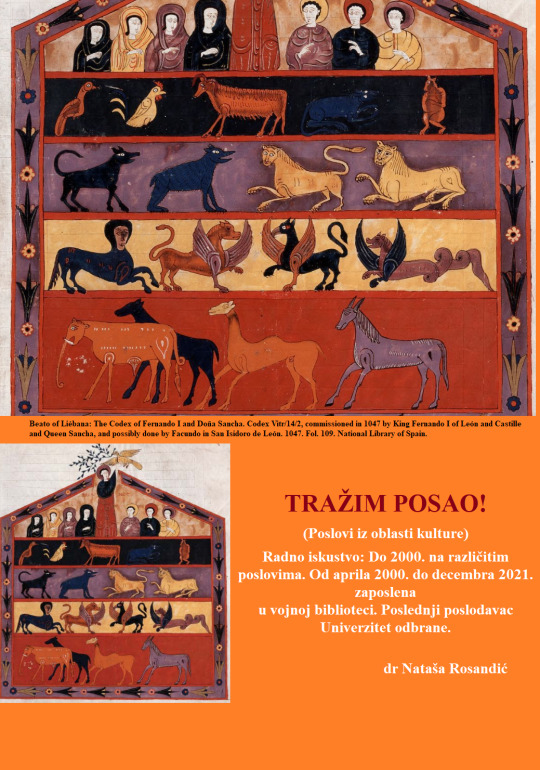#Beatus Manuscript
Text

Leaf from a Beatus Manuscript: the Lamb at the Foot of the Cross, Flanked by Two Angels; The Calling of Saint John with the Enthroned Christ flanked by Angels and a Man Holding a Book (Spain, c 1180 CE). Illustrated Beatus manuscripts bring to life an extraordinary vision of the end of the world, as recorded by Saint John in the Apocalypse (Book of Revelation) and filtered through the lens of Beatus of Liébana, an eighth-century Asturian monk. These manuscripts are unique to medieval Spain and a testament to the artistry and intellectual milieu of monastic culture there. The leaf shown here comes from a manuscript that was disassembled in the 1870s.
This frontispiece image depicts a lamb (an image commonly associated with Christ) tormented by the spear and sponge used against Christ during the Passion. The alpha and omega symbols hanging from the cross refer to a passage from the Apocalypse: "Ἐγώ εἰμι τὸ Ἄλφα καὶ τὸ Ὦ, λέγει κύριος, ὁ θεός, ὁ ὢν καὶ ὁ ἦν καὶ ὁ ἐρχόμενος, ὁ παντοκράτωρ." (that is: "I am Alpha and Omega, the beginning and the end, saith the Lord God, who is, and who was, and who is to come, the Almighty") (Apoc. 1:8)
[Robert Scott Horton]
* * * * *
“To hear is to let the sound wander all the way through the labyrinth of your ear; to listen is to travel the other way to meet it. It’s not passive but active, this listening. It’s as though you retell each story, translate it into the language particular to you, fit it into your cosmology so you can understand and respond, and thereby it becomes part of you. To empathize is to reach out to meet the data that comes through the labyrinths of the senses, to embrace it and incorporate it. To enter into, we say, as though another person’s life was also a place you could travel to.”
― Rebecca Solnit, The Faraway Nearby
[via "alive on all channels"]
#Easter#the cross#Lamb#Beatus Manuscript#angels#apocalypse#eighth century#religious art#Rebecca Solnit#quotes#Alive on All Channels#The Faraway Nearby
6 notes
·
View notes
Photo

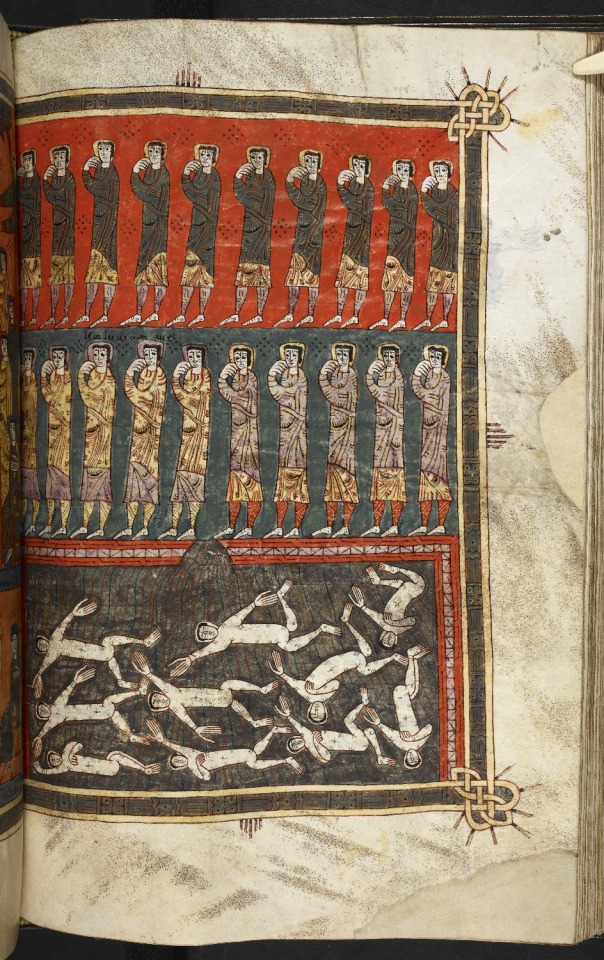
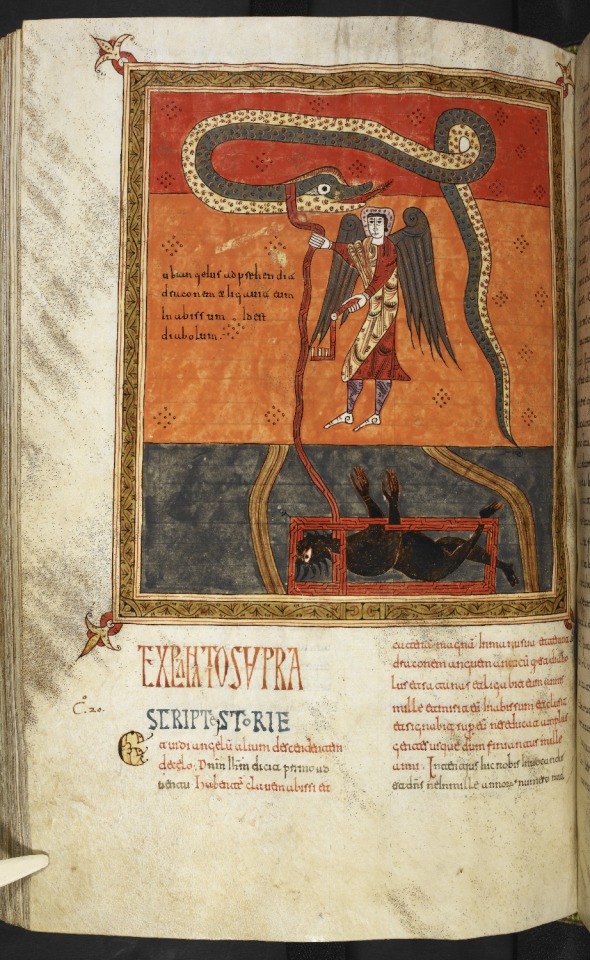



Beatus of Liébana, Commentary on the Apocalypse, Northern Spain, end of 10th century
Pages depicting the Last Judgement (top), the angel enchaining Satan (Revelation 20:1-3, middle left), angels restraining the four winds (Revelation 7:1-3, middle right), and the 144,000 chosen from the twelve tribes of Israel (Revelation 7:4-12, bottom)
British Library Catalogue of Illuminated Manuscripts (Additional 11695)
3K notes
·
View notes
Text
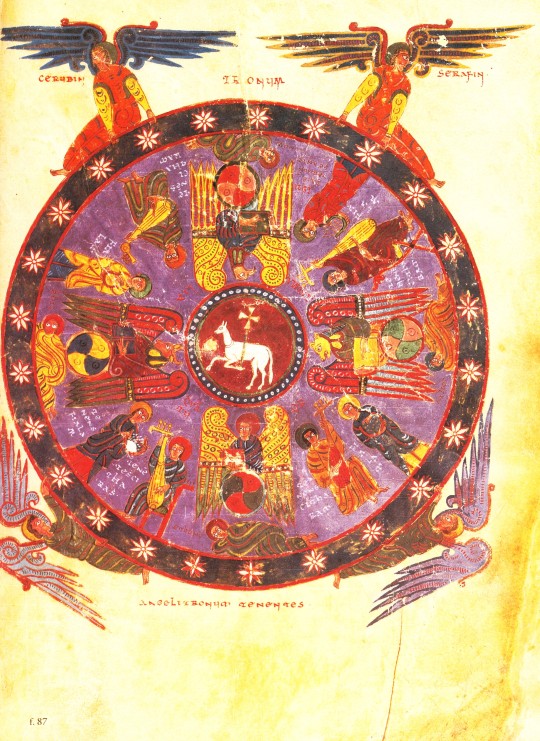

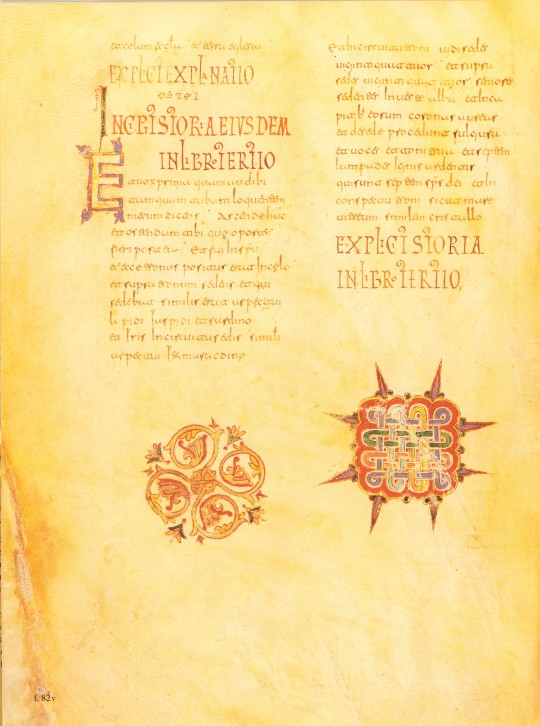
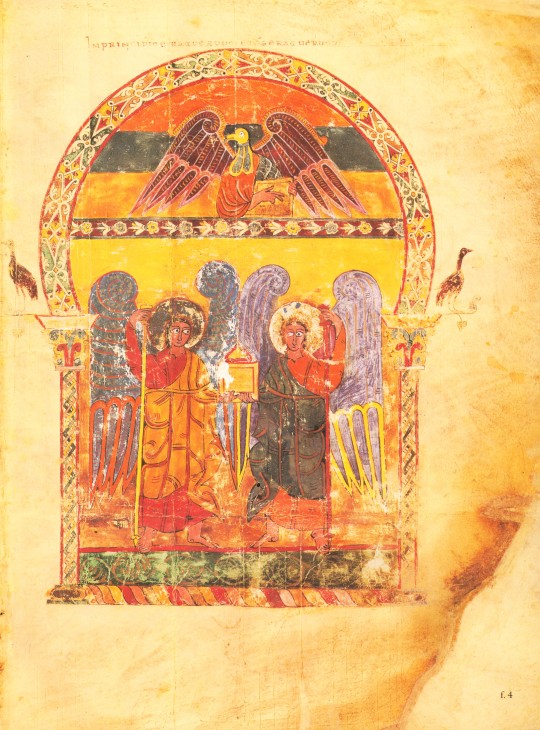




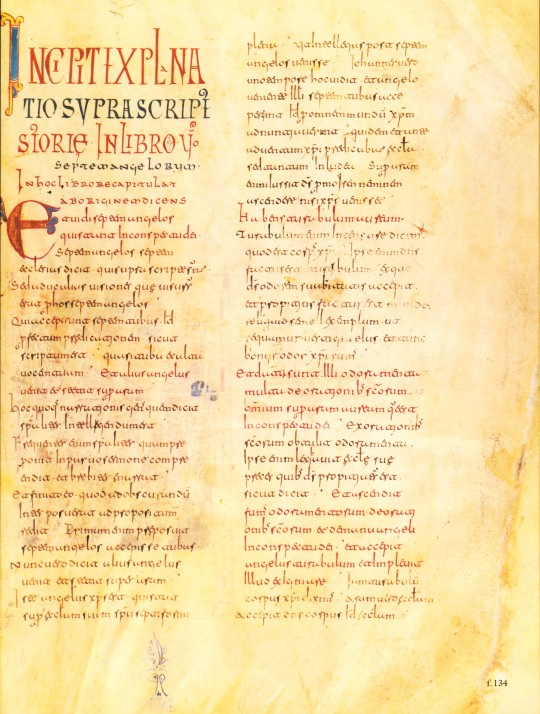
Welcome to Manuscript Monday!
In this series we will periodically focus on selections from our manuscript facsimile collection. Today we present selections from the Morgan Beatus Manuscript, reproduced as A Spanish Apocalypse, The Morgan Beatus Manuscript in New York by George Braziller, Inc. in association with the Pierpont Morgan Library in 1991. The original manuscript, made around 10th century CE at the scriptorium of San Miguel de Escalada in Spain by a monk named Maius, is the earliest surviving illuminated version of the monk Beatus of Liébana's commentary on the biblical Book of Apocalypse (also known as the Book of Revelation). The text of the Book of Revelation makes up the first part of the manuscript, and Beatus’s commentary comprises the second part. The Book of Revelation tells of the end-times in Christianity, during the final judgement of humanity by God. The story within this Biblical book was also seen by those living during the Latin medieval era as representative of the beginning of something new: God’s celestial kingdom. Due to this view of the book, many artists incorporated imagery from this part of the Bible in their work.
Produced in Al-Andalus, or Muslim-ruled Spain, the artistic style of this work combines both Muslim and Christian visual traditions to create a beautifully illuminated manuscript that supplements the commentary by the monk. This artistic style is known as the Mozarabic, which comes from the Arabic mustaʿrib, meaning ‘Arabicized’. Interestingly, this style of art can only be seen in Christian religious art and architecture from Spain at the time, as non-religious artistic objects made by Christians look so similar to Islamic versions of the same works that they cannot be identified as intentionally Christian. Some key Islamic artistic elements within the manuscript include buildings with horseshoe arches, intricate geometric and vegetal patterns as borders for larger images, and the large, bulging eyes of the illustrated animals.
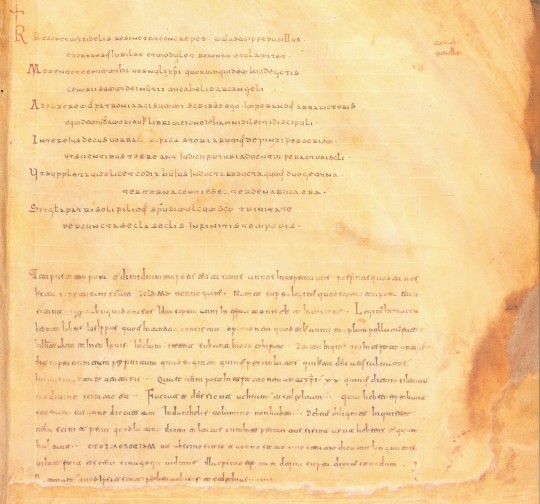
Another interesting aspect of this specific manuscript is the colophon at the end of the manuscript. It tells readers about the circumstances surrounding the creation of this book, including the maker, the patron, the year it was made, and an explanation about why Maius created the manuscript ("I write this . . . at the command of Abbot Victor, out of love for the book of the vision of John the beloved disciple. As part of its adornment I have painted a series of pictures . . . so that the wise may fear the coming of the future judgement of the world's end."). Colophons in medieval manuscripts are not usually as detailed, so the inclusion of all this information contributes greatly to the knowledge and history surrounding the Morgan Beatus Manuscript.
View more Manuscript Monday posts.
– Sarah S., Special Collections Graduate Intern
#manuscript monday#manuscripts#morgan library#morgan beatus manuscript#Beatus of Liébana#Spain#Christian art#Mozarabic#Islamic art style#facsimilies#Spanish art#Medieval art#Spanish medieval art#A Spanish Apocalypse#George Braziller#illuminated manuscripts#Sarah S.
133 notes
·
View notes
Text

a bird killing a serpent as an allegory for christ destroying satan
in the "rylands beautus" (beatus of liébana's commentary on the apocalypse of st john), latin illuminated manuscript, spain, late 12th or early 13th c.
source: Manchester, John Rylands University Library, Latin MS 8, fol. 14r
#medieval art#12th century#13th century#rylands beautus#beatus of liébana#bird#serpent#satan#medieval illumination#illuminated manuscript#christian iconography
135 notes
·
View notes
Photo

Painted by Ende or En, The Last Judgment, from the Gerona Beatus
#En#Ende#10th century art#Apocalypse#The Last Judgment#Gerona Beatus#medieval period#Middle Ages#theology#Christianity#manuscripts#Pre-Romanesque#Spain#Mozarabic#female artists
4 notes
·
View notes
Photo

MINIATURIST, Spanish
Beatus of Liébana: Commentary on the Revelation of St. John
before 1000
Manuscript (Cod. & II. 5), 395 x 225 mm
Real Biblioteca de San Lorenzo, El Escorial
141 notes
·
View notes
Photo
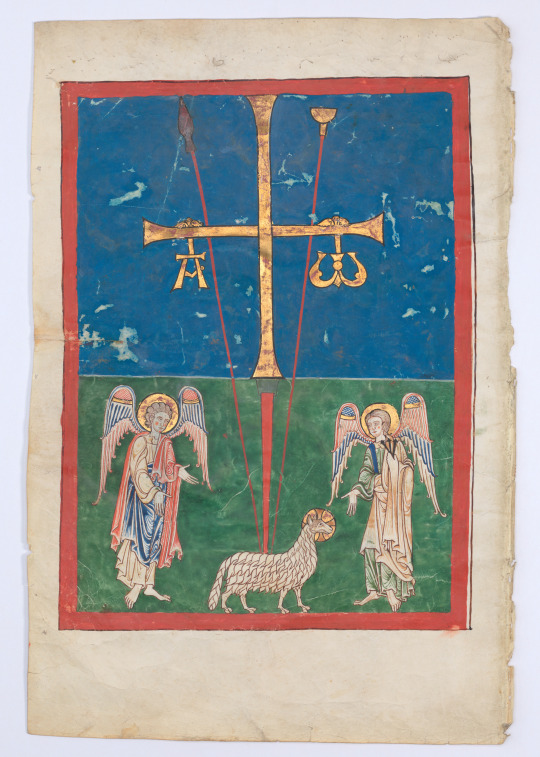
Leaf from a Beatus Manuscript: the Lamb at the Foot of the Cross, Flanked by Two Angels; The Calling of Saint John with the Enthroned Christ flanked by Angels and a Man Holding a Book. ca. 1180. Credit line: Purchase, The Cloisters Collection, Rogers and Harris Brisbane Dick Funds, and Joseph Pulitzer Bequest, 1991 https://www.metmuseum.org/art/collection/search/466190
#aesthetic#art#abstract art#art museum#art history#The Metropolitan Museum of Art#museum#museum photography#museum aesthetic#dark academia
11 notes
·
View notes
Text
the name of the rose enjoyers: free metropolitan museum of art pdf analyzing and contrasting the beatus of liébana apocalypse manuscripts including an analysis of pigment & production
30 notes
·
View notes
Photo
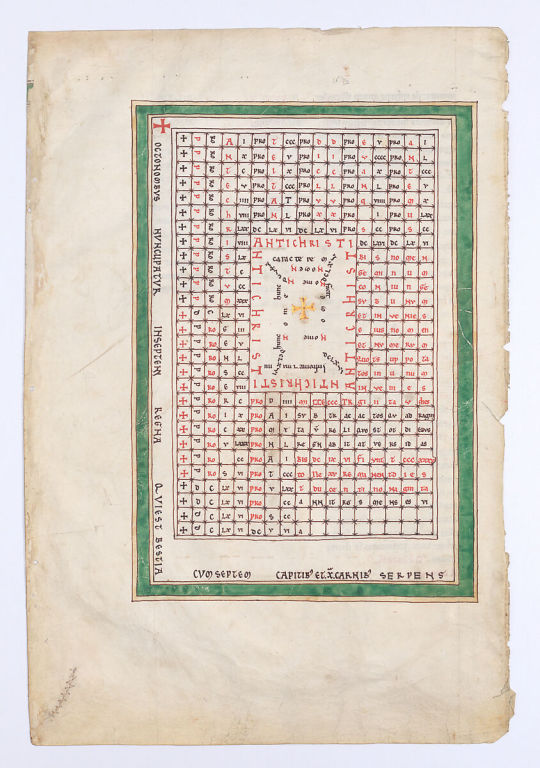
Leaf from a Beatus Manuscript: Table of the Antichrist
Spanish, 1180
18 notes
·
View notes
Text
People I Want to Get to Know
Thank you for the tag @suspensefulpen ! Really appreciated ;)
Last Song: Why - The Cranberries
Favorite Color: Blue
Last Film/Show: The Legend of Zorro
Sweet/Savory/Spicy: Savory
Relationship Status: Single
Last Thing I Googled: Beatus' manuscripts of the apocalypse (stuff for my art exam)
Current Obsession: Berserk (i'm reading it right now and it's constantly on my mind)
Last Book: Inkheart
Looking Forward To: Finally ending my exam session and resuming writing (and living free)
Tags: @coreyhedgehog @pkondrugs
6 notes
·
View notes
Photo

Leaf from a Beatus Manuscript: the Lamb at the Foot of the Cross, Flanked by Two Angels; The Calling of Saint John with the Enthroned Christ flanked by Angels and a Man Holding a Book (Spanish, c 1180). Illustrated Beatus manuscripts bring to life an extraordinary vision of the end of the world, as recorded by Saint John in the Apocalypse (Book of Revelation) and filtered through the lens of Beatus of Liébana, an eighth-century Asturian monk. These manuscripts are unique to medieval Spain and a testament to the artistry and intellectual milieu of monastic culture there. The leaf shown here comes from a manuscript that was disassembled in the 1870s.
This frontispiece image depicts a lamb (an image commonly associated with Christ) tormented by the spear and sponge used against Christ during the Passion. The alpha and omega symbols hanging from the cross refer to a passage from the Apocalypse: "I am Alpha and Omega, the beginning and the end, saith the Lord God, who is, and who was, and who is to come, the Almighty" (Apoc. 1:8)
[Robert Scott Horton]
* * * *
"This life is too much trouble, far too strange, to arrive at the end of it and then to be asked what you make of it and have to answer, ‘Scientific humanism." That won’t do. A poor show. Life is a mystery, love is a delight. Therefore I take it as axiomatic that one should settle for nothing less than the infinite mystery and the infinite delight, i.e. God. In fact, I demand it. I refuse to settle for anything less."
—Walker Percy, from Questions They Never Asked Me
(Lord John Press, 1979)
[alive on all channels]
#Beatus Manuscript#Lamb at the Foot of the Cross#Illustration#Scott horton#Alive On All Channels#Walker Percy#quotes#theology#mystery#religious art
11 notes
·
View notes
Photo

Beatus of Liébana, illustration from “Commentaria in Apocalypsin” ("Commentary on the Apocalypse”, in the Saint-Sever Beatus), Saint-Sever Abbey, Duchy of Gascony (today France), 1028-1072
BnF, Latin 8878, fol. 261
92 notes
·
View notes
Text
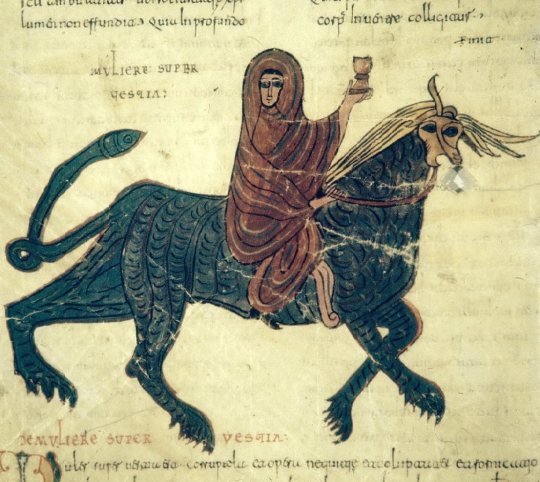
The Whore of Babylon, from the Valcavado Beatus Apocalipsis, an illuminated manuscript copied by a monk called Oveco in the year 970. Our Lady of Valcavado monastery in Palencia, Spain
0 notes
Text
Revelation 16: The Second Bowl
The bowl means death to every living thing. No survivors, no second chances.
Then, the second poured out his broad and shallow ceremonial cup into the sea and it became blood like that which is dead, and every breath of life died, the things in the sea.
Revelation 16:3
The Saint-Sever Beatus, also known as the Apocalypse of Saint-Sever, (Paris, Bibliothèque Nationale, MS lat. 8878) is a French Romanesque illuminated Apocalypse manuscript from the 11th Century | By…

View On WordPress
#Apocalypse#bowl of wrath#john&039;s apocalypse#Revelation 16#Revelation 16:3#sea turned to blood#second bowl
0 notes
